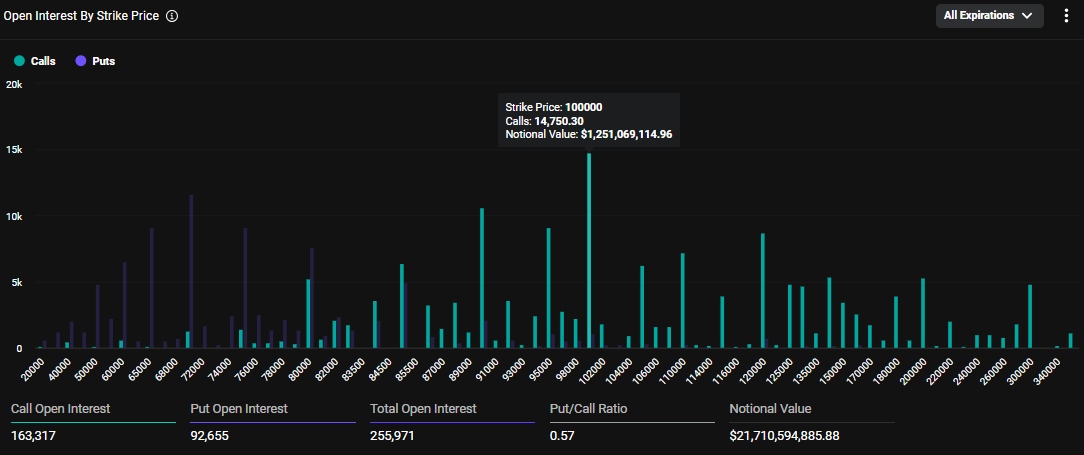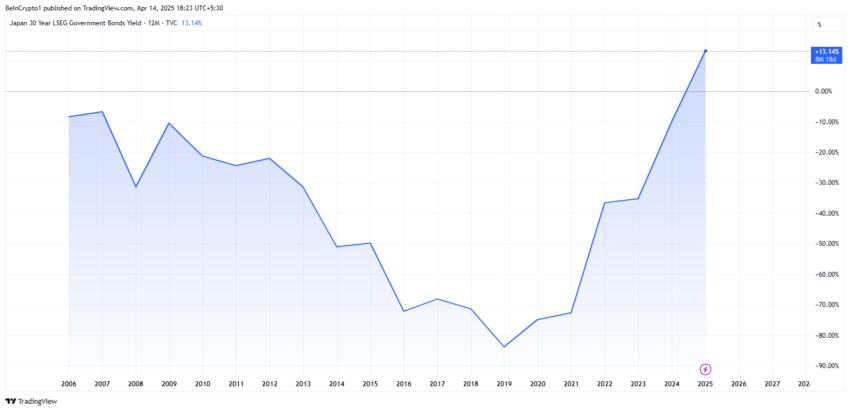-
Japan’s 30-year bond yields surge to 2.345%, the highest since 2004, signaling risk-averse behavior and potential pressure on Bitcoin.
-
A Bank of Japan rate hike could unwind the yen carry trade, draining global liquidity and affecting crypto markets.
-
Despite rising bond yields, Bitcoin call options show optimism, with a $100,000 target gaining popularity among traders.
Explore today’s crypto landscape as Japan’s bond yields rise, influencing Bitcoin dynamics and market liquidity with emerging trader opportunities.
Japan’s 30-Year Bond Yield Surges to Multi-Decade Highs
Japan’s 30-year bond yield has surged to the highest level in 20 years, trending as the top US crypto news today. Specifically, it has increased by 12 basis points (bps) to 2.345%, the highest level since 2004. This signals deepening stress in global fixed-income markets.
It is bearish on Bitcoin (BTC) and risk-on assets. Agne Linge, director of growth at decentralized on-chain bank WeFi, agrees that growing bond yields threaten crypto in the short term.
In an email to COINOTAG, Linge said a major shift might be in the pipeline for risk assets. She cited macroeconomic trends in Japan as they pertain to the current surge in the 30-year bond yield.
“With the bond yield jumping 2.345% to its highest level in 30 years, more risk-averse institutional investors might shun Bitcoin and other speculative assets,” Linge stated.
As Japan’s long-term bond yields surge, pressure is mounting on the Bank of Japan (BoJ) to respond with a possible interest rate hike. Analysts say this could happen as early as the end of April.
If the BoJ tightens policy, it would mark a significant shift for a central bank that has maintained ultra-loose monetary conditions for decades.
“If this forecast plays out as expected, it might lead to dried-up liquidity in the traditional financial market. Since crypto thrives more on excess monetary liquidity, this could also influence the performance of the asset shortly,” she added.
Linge cited the yen carry trade as one of the risk mechanisms. In this strategy, global investors borrow yen at low interest rates to invest in higher-yielding assets abroad. Trade thrives when Japanese rates are low and the international risk appetite is strong.
What Does It Mean for Bitcoin?
As Japanese yields rise and the prospect of a BoJ rate hike grows, the incentive to borrow yen diminishes. This could lead to an unwinding of the carry trade, potentially draining liquidity from global markets.
Such an outcome would amplify downside risk for crypto and other risk assets, which aligns with COINOTAG’s recent report that Bitcoin’s price is at risk as the reverse yen carry trade unwinds.
“The problem today is that those borrowing costs are starting to get more expensive. Traders who were able to access virtually free capital for years are now finding themselves sitting on costly margin positions that they’re potentially being forced to unwind,” 5x Dow & Founders award winner and portfolio manager Michael A. Gayed said recently.
Meanwhile, the Federal Reserve (Fed) is facing increasing pressure to cut interest rates. Consumer inflation data from the US CPI and PPI (Consumer Price Index and Producer Price Index, respectively) support this push. Linge observes that dovish signals in the US could partially offset this emerging hawkish stance from Japan.
“Since the US is a bigger market, the world may respond more toward the country’s monetary policies than Japan,” Linge added.
The Fed’s move to ease monetary conditions while Japan tightens could create a mixed global liquidity environment. This could spur volatility as investors reassess cross-border capital flows.
Nonetheless, the yen carry trade remains especially vulnerable to the BoJ’s decisively hawkish shift. This could trigger a repricing of risk globally, curbing speculative flows and weakening the liquidity backdrop that crypto markets have benefited from in recent years.
Amidst these concerns, however, traders and analysts remain optimistic. Analysts at Deribit recently observed that markets switched from capitulation to aggressive bounce.
“Protective/Bear play BTC 75-78k Puts were dumped, and 85-100k Calls were lifted as BTC surged from 75-85k,” they wrote.

Deribit data corroborates this observation, showing the $100,000 call strike price was the most popular call option as of this writing, recording the highest open interest. This suggests bets that Bitcoin could draw toward this psychological milestone.
Chart of the Day

US Crypto News: Byte-Sized Alpha
- Crypto outflows hit $795 million last week as Trump’s tariffs weigh heavy on investor sentiment.
- Bitcoin is set to hit ATH in 2025, and experts predict a 77% probability based on mathematical data.
- Personal data from Ledger, Gemini, and Robinhood users is being sold on the dark web, sparking renewed crypto sector security fears.
- Bitcoin funds see a 314% surge in weekly outflows, and the derivatives market is witnessing a decline in open interest.
- RFC token surged over 1,000% in April, fueled by memes, Musk, and whales.
- Flare (FLR) hits a weekly high with a 57% surge as indicators signal more upside.
- Pi coin sees double-digit rise after Chainlink integration.
Crypto Equities Pre-Market Overview
| Company | At Close April 11 | Pre-Market Overview |
| Strategy (MSTR) | $299.98 | $312.00 (+4.00%) |
| Coinbase Global (COIN) | $175.50 | $180.42 (+2.80%) |
| Galaxy Digital Holdings (GLXY) | $15.28 | $15.30 (+0.13) |
| MARA Holdings (MARA) | $12.51 | $13.03 (+4.16) |
| Riot Platforms (RIOT) | $7.06 | $7.06 (+3.97%) |
| Core Scientific (CORZ) | $7.07 | $7.26 (+2.69%) |
Conclusion
In light of Japan’s shifting economic landscape, the implications for Bitcoin and broader crypto markets are significant. With rising yields and potential policy shifts on the horizon, traders should exercise caution. However, the burgeoning interest in Bitcoin call options may indicate a strong belief in its long-term potential, even in a tightening liquidity environment. As always, staying informed and vigilant will be crucial for navigating these turbulent financial waters.
